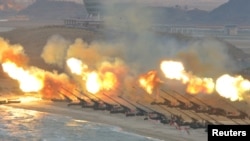Thousands of North Korean artillery shells raining down on Seoul. Hundreds of tons of high explosives detonating in the densely populated South Korean capital. Missile strikes as far away as Japan and the U.S. territory of Guam.
These are just some of the possible consequences U.S. and South Korean military planners must take into account as they consider a pre-emptive strike to halt Pyongyang's steady advances toward developing an offensive nuclear capability.
U.S. President Donald Trump's administration has repeatedly said it is finished with its predecessor's policy of “strategic patience” toward North Korea, suggesting the possibility of military action to prevent the North from developing a nuclear tipped intercontinental ballistic missile (ICBM) that could reach the U.S. mainland.
Adding military muscle to the rhetoric, a U.S. submarine designed to carry 150 Tomahawk cruise missiles entered a South Korean port on Tuesday. The USS Carl Vinson aircraft carrier group is also heading to the region and conducting naval exercises with Japan and South Korea. And the United States this week began to move part of the THAAD missile defense system to its deployment site 250 kilometers south of Seoul.
Rain of fire
But analysts say there are high risks associated with any U.S. first strike. A surgical U.S. missile strike to take out one or multiple nuclear or missile sites would likely not be sufficient to destroy or degrade North Korea’s nuclear and ballistic missile arsenals, which are reportedly in numerous fortified underground sites across the country.
But a U.S. preventive strike would almost certainly trigger an immediate North Korean retaliation against South Korea.
“It might involve artillery attacks on Seoul or elsewhere along the demilitarized zone [DMZ.] It might involve covert operations, but they have several levels of escalation to go before they get to nuclear or even chemical weapons,” said John Schilling, a missile technology specialist with 38 North, a North Korea monitoring website run by Johns Hopkins University's School of Advanced International Studies (SAIS) in Washington.
North Korea has more than 21,000 artillery weapons, positioned mostly along the inter-Korean border, that could put in jeopardy the lives of 25 million people that live in and around Seoul, the South Korean capital located 56 kilometers south of the border.
An assessment of North Korean military capabilities by Strafor, an intelligence analysis organization in Texas, notes the North's artillery arsenal includes 300mm multiple rocket launcher systems that can “rain fire across” Seoul and beyond. “A single volley,” a Strafor report said, “could deliver more than 350 metric tons of explosives across the South Korean capital, roughly the same amount of ordnance dropped by 11 B-52 bombers.”
Nuclear missiles
North Korea has more than one thousand ballistic missiles that could strike across South Korea, Japan and possibly as far away as U.S. military bases in Guam.
While the North has not yet demonstrated it can successfully mount a miniaturized nuclear warhead on a missile, U.S. and South Korean officials have said they believe Pyongyang has a nuclear Nodong missile that can fire a one ton warhead a distance of up to two thousand kilometers, which would put all of South Korea, most of Japan and parts of Russia and China in range.
“I think the majority of people now believe they can put a warhead on top of a missile that can hit targets in Northeast Asia. But when you get to the much longer range they need, such as hitting the United States, I think, we don’t know for sure. But most people would believe that it is a work in progress,” said Joel Wit, the co-founder of 38 North and a senior fellow at the U.S.-Korea Institute at SAIS.
In addition to the 10 to 20 nuclear warheads North Korea is believed to have, its missiles could also be armed with deadly chemical weapons from suspected stockpiles of sarin nerve gas.
A Nodong is a single stage liquid fuel rocket based on scud missiles developed by the former Soviet Union. Some of North Korea’s most recent tests were solid fuel Musudan missiles that have an estimated maximum range of three thousand kilometers, which could potentially reach targets in Japan and as far away as U.S. military bases in Guam. If left unchecked, analysts say, North Korea is on track to develop an ICBM by 2020 that could reach the U.S. mainland. Pyongyang is also developing a submarine launch ballistic missile (SLBM) capability.
The more than 28,000 U.S. forces in Korea and 50,000 troops in Japan would also be possible targets for any North Korea retaliatory strikes.
Analysts say any North Korean counter strike would draw a quick response from the United States, South Korea and Japan that could further escalate the conflict, draw in China, and lead to a second Korean war.
Youmi Kim contributed to this report













